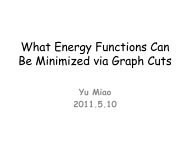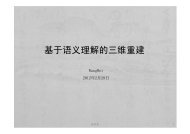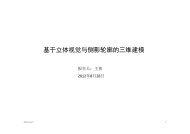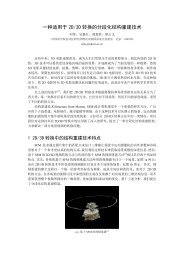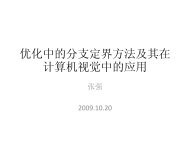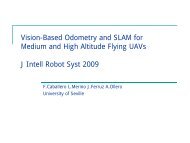Accurate, Dense, and Robust Multi-View Stereopsis
Accurate, Dense, and Robust Multi-View Stereopsis
Accurate, Dense, and Robust Multi-View Stereopsis
You also want an ePaper? Increase the reach of your titles
YUMPU automatically turns print PDFs into web optimized ePapers that Google loves.
IEEE Computer Society Conference on Computer Vision <strong>and</strong> Pattern Recognition, July 2007.<br />
To appear in IEEE Transactions on Pattern Analysis <strong>and</strong> Machine Intelligence, 2009.<br />
<strong>Accurate</strong>, <strong>Dense</strong>, <strong>and</strong> <strong>Robust</strong><br />
<strong>Multi</strong>-<strong>View</strong> <strong>Stereopsis</strong><br />
(PMVS)<br />
Yasutaka Furukawa <strong>and</strong> Jean Ponce, Fellow, IEEE<br />
2009.12.1
Abstract<br />
This article proposes a novel algorithm for multiview stereopsis that<br />
outputs a dense set of small rectangular patches covering the<br />
surfaces visible in the images. <strong>Stereopsis</strong> is implemented as a<br />
match, exp<strong>and</strong>, <strong>and</strong> filter procedure, starting from a sparse set of<br />
matched keypoints, <strong>and</strong> repeatedly exp<strong>and</strong>ing these before using<br />
visibility constraints to filter away false matches. Simple but effective<br />
methods are also proposed to turn the resulting patch model into a<br />
mesh which can be further refined by an algorithm that enforces<br />
both photometric consistency <strong>and</strong> regularization constraints. A<br />
quantitative evaluation on the Middlebury benchmark shows that the<br />
proposed method outperforms all others submitted so far for four out<br />
of the six datasets.
Key procedures of PMVS<br />
(1) Feature detection <strong>and</strong> matching:<br />
features found by Harris <strong>and</strong> Difference-of-Gaussians operators<br />
are matched across multiple pictures, yielding a sparse set of<br />
patches.<br />
The procedure (2) <strong>and</strong> (3)iterative 3 times<br />
(2) Expansion:<br />
a technique is used to spread the initial matches to nearby pixels<br />
<strong>and</strong> obtain a dense set of patches.<br />
(3) Filtering:<br />
visibility constraints are used to eliminate incorrect matches<br />
lying either in front or behind the observed surface.<br />
(4) Polygonal surface reconstruction
• Cell: we associate with each image a<br />
regular grid of pixels cells Ci(x, y)<br />
• V(p) <strong>and</strong> V*(p): V(p) denote a set of<br />
images in which patch p is visible.<br />
• Qi(x,y) <strong>and</strong> Q ∗ i (x, y) : given a patch p<br />
<strong>and</strong> its visible imagesV(p), we simply<br />
project p into each image in V(p) to<br />
identify the corresponding cell. Then,<br />
each cell Ci(x, y) remembers the set of<br />
patches Qi(x, y) that project into it.<br />
Similarly, we use Q ∗ i (x, y) to denote<br />
the patches that are obtained by the<br />
same procedure, but with V∗(p)<br />
instead of V(p).<br />
Some definitions
Feature detection <strong>and</strong> matching
Feature detection <strong>and</strong> matching
Feature detection <strong>and</strong> matching
Feature detection <strong>and</strong> matching
Feature detection <strong>and</strong> matching
Feature detection <strong>and</strong> matching
Feature detection <strong>and</strong> matching<br />
optimization
Feature detection <strong>and</strong> matching
Feature detection <strong>and</strong> matching
Expansion<br />
• Identifying Cells for expansion<br />
• Expansion procedure
Identifying Cells for expansion<br />
Given a patch p ,we initialize C( p)<br />
by collecting<br />
the neighboring image cell in its each visible<br />
image:<br />
The expansion procedure is not performed for an image cell if<br />
1. an image cell Ci( x', y') ∈C( p)<br />
contains a patch p,<br />
' which is a<br />
neighbor of p , Ci( x', y')<br />
is removed from the set of C( p)<br />
2. Ci( x', y')<br />
already contains a patch whose photometric<br />
discrepancy score associated with Ii<br />
is better than the<br />
threshold α.
Expansion procedure
p<br />
Filtering<br />
A patch will be removed in the following three situations:<br />
1. p<strong>and</strong> p 'are<br />
not neighbors,but are stored in the same<br />
cell of one of the images where p is visible. Then p is<br />
filtered out as an outliers if the following inequality<br />
holds<br />
* 2. If the number of images in V ( p)<br />
according to depthmap<br />
test is less than γ.<br />
3. If the proportion of patches that are neighbors of p<br />
in<br />
V( p)<br />
is lower than 0.25.
Some results in the paper
test


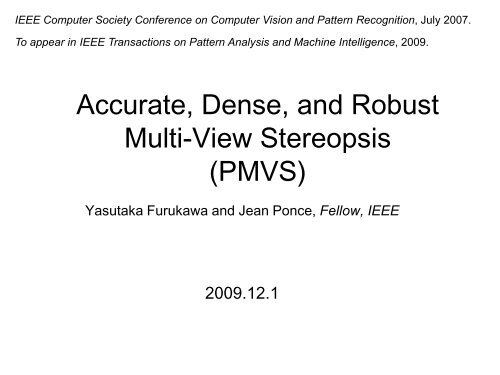
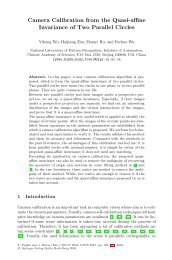
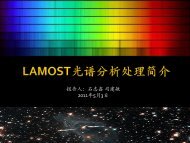
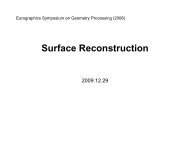
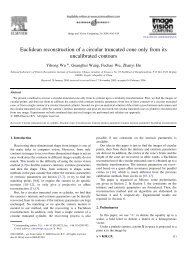
![Accurate, Dense, and Robust Multi-View Stereopsis (PMVS) [1,2,3]](https://img.yumpu.com/19388840/1/190x135/accurate-dense-and-robust-multi-view-stereopsis-pmvs-123.jpg?quality=85)


